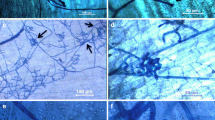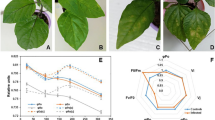Abstract
The virus origin of a Czechoslovak isolate of potato witches' broom disease is discounted: electron micrographs of ultrathin section of phloem tissues from plants infected with potato witches' broom disease demonstratedMycoplasma-like bodies, spherical or elongated showing binary fission and fragmentation. The minute corpuscles have a diameter of about 50–60 nm, the largest bodies of 1000 nm. The width of elongated filamentous structures is about 200 nm, most oval bodies have a diameter of 250 nm. A weak tetracycline treatment of diseased plants causes a delay of symptom development; a strong dose of tetracycline (applied by means of the wick method into the stem) inhibits symptom appearance completely. Tetracycline produces a phytotoxic effect inhibiting the growth of tomato plants and causing (at higher concentrations) necrosis and death of these plants. There is a note in the paper dealing with the term “mycoplasma”. The word mycoplasma in the sense ofEriksson (1897) or ofMereschkowsky (1910) does not correspond to the genus nameMycoplasma Nowak (1929).
Abstract
Práce popírá virovou etiologii metlovitosti bramboru: na elektronogramech ultratenkých žezů lýkem rostlin nakažených metlovitostí bramboru byly zjištěny částice připomínajícíMycoplasma, kulovité nebo vláknité, které se větví nebo se z nich odškrcují menší tělíska. Nejmenší tělíska mají průměr 50–60 nm, největší 1000 nm. Vlákna jsou tlustá obvykle kolem 200 nm, oválná tělíska mají nejčastější průměr 250 nm. Slabá dávka tetracyklinu zpožduje vývoj příznaků infikovaných rostlin, silná dávka (po aplikaci tetracyklinu knotem do stonku) úplně zabrání vývoji příznaků metlovitosti. Tetracyklin však působí toxicky na rostliny, inhibuje jejich růst a ve vyšší dávce působí nekrózy i uhynutí. V práci je terminologická poznámka: termín mycoplasma ve smysluErikssonově (1897) ani ve smysluMereschkowského (1910) nesouvisí s rodovým označením mikroorganismůMycoplasma Nowak (1929).
Similar content being viewed by others
References
Bojňanský, V., Blattný, C., Laffers, E.: K výskytu metlovitosti bramborů v ČSR. [On the occurence of potato witches' broom disease in Czechoslovakia.]— Preslia30: 360, 1958.
Brčák, J., Králík, O.:Mycoplasma-like microorganisms and virus particles in the leafhopperJavesella pellucida (F.) transmitting the oat sterile dwarf disease.—Biol. Plant.11: 95–96, 1969.
Cousin, M. T., Maillet, P. L., Gourret, J. P., Grison, C., Staron, T.: Présence de particules de type “Mycoplasme” dans le phloème de plantes infectées par trois maladies de type “Jaunisse européenne”: de stolbur, de la tomate, l'aster yellow du glaieul, la phyllodie du trèfle. Études cytologique et ultrastructurale. Premiers essais de lutte chimique.—Acad. Agric. France, Extrait du procès-verbal de la Séance du 9 Octobre pp. 887–895, 1968.
Davis, R. E., Whitcomb, R. F., Steere, R. L.: Chemotherapy of aster yellows disease.— Phytopathology58: 884, 1968.
Doi, Y., Teranaka, M., Yora, K., Asuyama, H.: Mycoplasma- or PLT group-like micro-organisms found in the phloem elements of plants infected with mulberry dwarf, potato witches' broom, aster yellows, or Paulownia witches' broom.—Ann. Phytopath. Soc. Japan33: 259–266, 1967.
Edward, D. G. F. F., Frundt, E. A.: The classification and nomenclature of organisms of the pleuropneumonia group.—J. gen. Microbiol.14: 197–207, 1956.
Eriksson, J.: Vie latente et plasmatique de certaines urédinées.—C. R. Acad. Sci. Paris124: 475, 1897.
Eriksson, J.: Über die Mycoplasmatheorie, ihre Geschichte und ihren Tagesstand.—Biol. Cbl.30: 618–623, 1910.
Fukushi, T., Shikata, E., Shioda, H., Sekiyama, E., Tanaka L., Oshima, N., Nishia, Y.: Insect transmission of potato witches' broom in Japan.—Proc. Jap. Acad.31: 234–236. 1955.
Granados, R. R., Maramorosch, K., Shikata, E.: Mycoplasma: suspected etiologic agent of corn stunt.—Proc. nat. Acad. Sci. (Wash.)60: 841–844, 1968.
Ishiie, T., Doi, Y., Yoda, K., Asuyama, H.: Suppressive effects of antibiotics of tetracycline group on symttom development of mulberry dwarf disease.—Ann. Phytopath. Soc. Japan33: 267–275, 1967.
Limberk, J.: Beitrag zur Kenntnis der Stammzusammensetzung der Kartoffelhexenbesen-krankheit.—Preslia32: 407, 1960.
Macht, D. I., Livingston, M. B.: Effect of cocaine on the growth ofLupinus albus. A contribution to the comparative pharmacology of animal and plant protoplasm.—J. gen. Physiol.4: 573–584, 1922.
Macovschi, E.: Metoda capilará pentru introducerea compusilor chimici si produsilor biologici în corpul plantelor. [Méthode capillaire pour l'introduction dés composés chimiques et produits biologiques dans le corps des plantes.]—Comunicárile Acad. RP Romîne8: 183–187, 1958.
Maillet, P. L., Gourret, J. P., Hamon, C.: Sur la présence de particules de type Mycoplasme dans le liber de plantes atteintes de maladies du type “jaunisse” (Aster Yellow, Phyllodie du Trèfle, Stolbur de la Tomate) et sur la parenté ultrastructurale de ces particules avec celles trouvées chez divers Insectes Homoptères.—C. R. Acad. Sci. Paris266 (D): 2309–2311, 1968.
Maramorosch, K., Shikata, E., Granados, R. R.: Structures resemblingMycoplasma in diseased plants and in insect vectors.—Transactions N. Y. Acad. Sci.30: 841–855, 1968.
Mereschkowsky, C.: Theorie der zwei Plasmaarten als Grundlage der Symbiogenesis, einer neuen Lehre von der Entstehung der Organismen.—Biol. Cbl.30: 278–288, 1910.
Milne, R.: Electron microscopy of leaves infected with sowbane mosaic virus and other small polyhedral viruses.—Virology32: 589–600, 1967.
Nowak, J.: Morphologie, nature et cycle évolutif du microbe de la péripneumonie des bovidés.— Ann. Inst. Pasteur43: 1330–1352, 1929.
Raynolds, E. S.: Use of lead citrate at high pH as an electron-opaque stain in electronmicroscopy.— J. Cell Biol.17: 209, 1963.
Steinbrecht, R. A., Ernst, K.-D.: Continuous penetration of delicate tissue specimens with embedding resin (24).—Science Tools14(2), August, 1967.
Tischler, G.: Kurzer Bericht über die von Eriksson und mir ausgeführten Untersuchungen über das vegetative Leben des Gelbrostes (Puccinia glumarum Erikss. etHenn.).—Biol. Cbl.24: 417–423, 1904.
Valenta, V.: Vírus metlovitosti zemiakov v Čeksoslovensku. (Príspevok k otázke “severného” stolburu.) [Potato witches', broom disease in Czechoslovakia.].—Biológia11: 449–456, 1956.
Valenta, V.: Otazka “severného stolburu” v Československu. [The problem of “North stolbur” in Czechoslovakia.] Stolbur a príbuzné vírusové bezsemennosti rastlín.—Sb. ved. konf. o stolbure a príbuzných bezsemennostiach, Smolenice1956: 168–177, 1958a.
Valenta, V.: Potato witches' broom virus in Czechoslovakia.—Proc. 3rd Conf. Potato Virus Dis., Lisse-Wageningen1957: 246–250, 1958b.
Wright, N. S.: Studies on the witches'-broom virus disease of potatoes in British Columbia.—Canad. J. Bot.30: 735–742, 1952.
Wright, N. S.: Potato witches' broom in North America.—Proc. 3rd Conf Potato Virus Dis., Lisse-Wageningen1957: 239–245, 1958.
Author information
Authors and Affiliations
Additional information
Address: Na Karlovce 1, Praha 6, Czechoslovakia.
The plates will be found at the end of the issue.
Rights and permissions
About this article
Cite this article
Brčák, J., Králík, O., Limberk, J. et al. Mycoplasma-like bodies in plants infected with potato witches' broom disease and the response of plants to tetracycline treatment. Biol Plant 11, 470–476 (1969). https://doi.org/10.1007/BF02920712
Received:
Issue Date:
DOI: https://doi.org/10.1007/BF02920712




